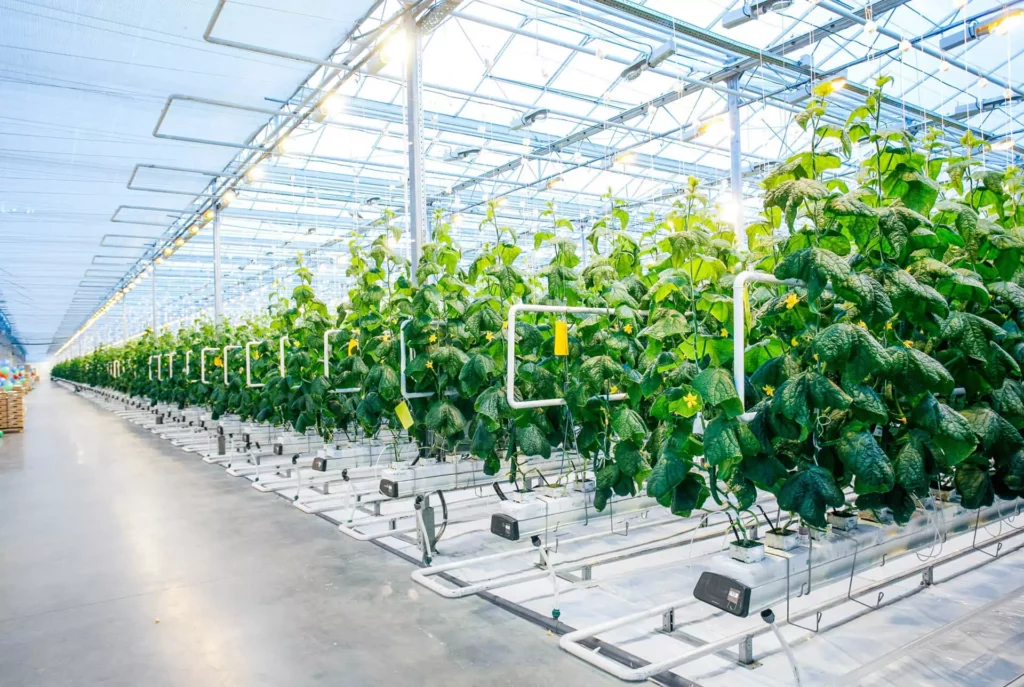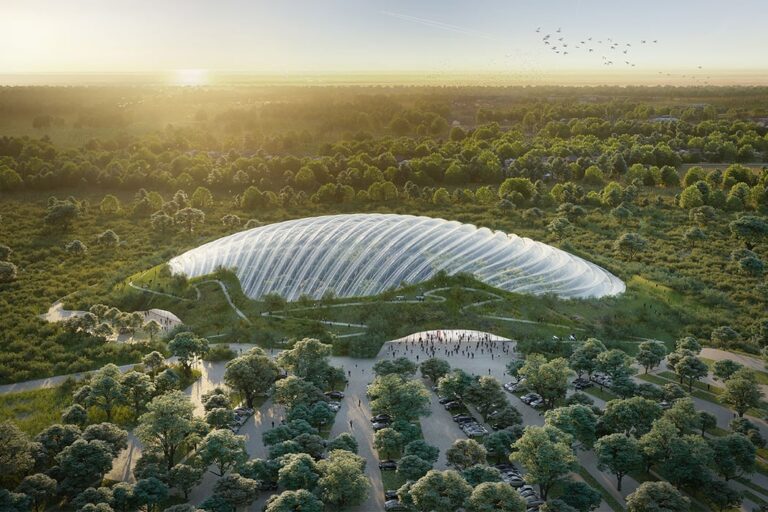Greenhouse farming technology revolutionizes agriculture by creating controlled environments for plant growth. These structures, made of materials like glass or polycarbonate, enable precise manipulation of factors such as temperature, humidity, and light. Climate control systems, including heaters, ventilation, and irrigation, ensure optimal conditions.
Supplemental artificial lighting, CO2 enrichment, and automation further enhance growth. Integrated pest management techniques protect crops while maximizing yields. Energy-efficient technologies and crop selection tailored to greenhouse conditions bolster sustainability and production.
Advanced analytics and AI-driven systems optimize operations. Greenhouse farming offers year-round cultivation, increased yields, and better crop quality, yet requires significant investment and technical expertise for successful implementation and maintenance.
How do different greenhouse structures vary in Greenhouse Farming?

Different greenhouse structures exhibit significant variations in Greenhouse Farming due to their diverse designs, construction materials, and technological applications. Traditional greenhouses often feature glass or plastic panels supported by frames, providing a controlled environment for plant growth.
In contrast, high-tech greenhouses employ advanced methodologies like controlled environment agriculture (CEA), integrating sophisticated systems for precise climate control, including temperature, humidity, and lighting regulation.
These high-tech setups embrace innovative farming techniques such as hydroponics, aeroponics, aquaponics, and vertical farming. Hydroponic systems cultivate plants in a soilless medium, where the roots are directly exposed to nutrient-rich water solutions.
Aeroponic systems suspend plant roots in an air or mist environment, ensuring efficient nutrient uptake. Aquaponic systems combine hydroponics with aquaculture, utilizing waste from aquatic organisms to nourish plants. Additionally, vertical farming optimizes space by stacking layers of crops vertically, maximizing production within limited areas.
The diversity in greenhouse structures profoundly impacts various aspects of farming, including crop growth, environmental sustainability, resource efficiency, and overall productivity. Each structure type has its distinct advantages and challenges, influencing the choice of technology implemented based on specific farming needs, geographical locations, and desired outcomes.
What are the essential components in Greenhouse Farming?
The essential components in Greenhouse Farming encompass a range of elements vital for successful cultivation within controlled environments:
Structure and Materials
The physical framework of the greenhouse, including materials like glass, polycarbonate, or plastic, provides the enclosure for plant growth.
Environmental Controls
Systems regulating temperature, humidity, and light levels, often involving heaters, fans, vents, shades, and artificial lighting setups to create an optimal growing environment.
Irrigation and Nutrient Delivery Systems
Methods for providing water, nutrients, and fertilizers to the plants, which can involve drip irrigation, hydroponic or aeroponic systems, or automated nutrient delivery systems.
Automation and Monitoring Technologies
Tools like sensors, controllers, and automated systems to monitor and control environmental factors such as temperature, humidity, CO2 levels, and irrigation schedules.
Growing Medium
The medium in which plants grow, which can include soil, soilless mediums (like perlite, rockwool, or coco coir), or hydroponic/aquaponic setups without soil.
Crop Support and Management Systems
Support structures such as trellises, stakes, or trays to help plants grow optimally and facilitate ease of management.
Pest and Disease Control Methods
Integrated Pest Management (IPM) strategies, including biological control agents, organic pesticides, or beneficial insects, to manage pests and diseases without harming the environment.
Energy Sources
Power sources for heating, cooling, lighting, and other technological components, which can be traditional electricity, renewable energy like solar or wind, or a combination of both.
These components collectively contribute to creating a controlled environment that optimizes plant growth, ensures efficient resource utilization, and facilitates the successful cultivation of various crops throughout the year.
How can sustainability be integrated into Greenhouse Farming?

Sustainability can be integrated into Greenhouse Farming through various practices and strategies aimed at minimizing environmental impact and resource consumption while maintaining or increasing productivity. Here are some ways:
Resource-Efficient Design
Constructing greenhouses using eco-friendly materials and employing energy-efficient designs to reduce the overall environmental footprint.
Water Conservation
Implementing water-saving technologies like drip irrigation, recycling and reusing water, collecting rainwater, and employing hydroponic or aeroponic systems that use significantly less water compared to traditional soil-based farming.
Energy Conservation
Utilizing renewable energy sources such as solar or wind power to meet energy demands within the greenhouse, reducing reliance on non-renewable energy and decreasing carbon emissions.
Integrated Pest Management (IPM)
Adopting environmentally friendly pest control methods such as introducing beneficial insects, using organic pesticides, and implementing cultural practices to reduce the need for chemical pesticides.
Soil Health and Conservation
Embracing soilless farming techniques like hydroponics or aeroponics to minimize soil degradation and erosion, while also optimizing nutrient uptake by plants.
Waste Management
Implementing strategies to recycle organic waste, utilizing composting methods, and employing closed-loop systems to minimize waste generation and maximize resource utilization.
Biodiversity and Ecosystem Support
Creating habitats for beneficial insects and organisms, promoting biodiversity within and around the greenhouse, and reducing the impact on local ecosystems.
Carbon Footprint Reduction
Employing efficient climate control systems, optimizing transportation routes, and using sustainable materials to reduce greenhouse gas emissions associated with production and operation.
Continuous Innovation
Investing in research and development of new technologies and methodologies that further enhance sustainability within greenhouse farming practices.
Integrating these sustainable practices into greenhouse farming not only reduces environmental impact but also contributes to long-term economic viability, ensuring the resilience and sustainability of agricultural practices for future generations.
FAQ’s
What are the advantages and disadvantages of greenhouse farming?
Advantages may include extended growing seasons, controlled environments, and increased crop yield. Disadvantages might involve high initial costs and intensive maintenance.
What are the advantages and disadvantages of the greenhouse effect?
The advantages involve keeping the Earth warm enough for life. Disadvantages include the enhanced greenhouse effect leading to global warming and climate change.
Is greenhouse advantageous or disadvantageous?
Greenhouses can be advantageous for controlled crop growth but might be disadvantageous due to their potential contribution to global warming when referring to the greenhouse effect.
What is the main purpose of a greenhouse?
The primary purpose of a greenhouse is to create a controlled environment for cultivating plants by regulating temperature, humidity, and light.
What are three disadvantages of the greenhouse effect, and why?
Three disadvantages are rising temperatures leading to climate change, altered weather patterns causing extreme events, and potential harm to ecosystems due to heat retention caused by greenhouse gasses.
What are the five important greenhouse components?
Essential components include the structure/materials, environmental controls (temperature, humidity, light), irrigation systems, automation/monitoring tech, and growing mediums/methods.
Final Words
In the end, Greenhouse Farming Technology helps farmers grow crops in a special place. It uses different kinds of structures and cool features to help plants grow better. Farmers can grow more food and different types of plants using these cool methods.
They also try to take care of nature by saving water, using less energy, and being nice to the soil and bugs. Greenhouse farming is important because it helps make more food and takes care of the Earth too.

